Contrasting the Impacts of Intraseasonal Oscillations on Yangtze Precipitation during the Summer of 1998 and 2016
Abstract
:1. Introduction
2. Data and Methods
2.1. Data
2.2. Methods
3. Results
3.1. The Intraseasonal Features of Summer Precipitation over the YRB in 1998 and 2016
3.2. The Evolution of BSISO1 and Its Impact on Yangtze Rainfall in 1998
3.2.1. BSISO1 Phase Evolution
3.2.2. Impact of BSISO1 on Yangtze Rainfall in Eight Phases
3.2.3. Source of Active Convection
3.3. The Evolution of BSISO2 and Its Impact on Yangtze Rainfall in 2016
3.3.1. BSISO2 Phase Evolution
3.3.2. Impact of BSISO2 on Yangtze Rainfall in Eight Phases
3.3.3. Source of Active Convection
3.4. SST and Atmospheric Circulation
3.4.1. June–July of 1998
3.4.2. June–July of 2016
4. Conclusions and Discussion
Author Contributions
Funding
Institutional Review Board Statement
Informed Consent Statement
Data Availability Statement
Acknowledgments
Conflicts of Interest
References
- Tao, S.-Y. A review of recent research on the East Asian summer monsoon in China. In Monsoon Meteorology; Oxford University Press: New York, NY, USA, 1987; pp. 60–92. [Google Scholar]
- Zhang, R. Relations of water vapor transport from Indian monsoon with that over East Asia and the summer rainfall in China. Adv. Atmos. Sci. 2001, 18, 1005–1017. [Google Scholar]
- Ninomiya, K.; Shibagaki, Y. Multi-Scale Features of the Meiyu-Baiu Front and Associated Precipitation Systems. J. Meteorolog. Soc. Jpn. Ser. II 2007, 85B, 103–122. [Google Scholar] [CrossRef]
- Ding, Y.; Wang, Z. A study of rainy seasons in China. Meteorol. Atmos. Phys. 2008, 100, 121–138. [Google Scholar]
- Hu, H.; Deng, Y.; Fang, J.; Wang, R. Mechanism of Regional Subseasonal Precipitation in the Strongest and Weakest East Asian Summer Monsoon Subseasonal Variation Years. J. Ocean Univ. China 2022, 21, 1411–1427. [Google Scholar] [CrossRef]
- Chan, J.C.L.; Wi, W.X.; Xu, J.J. Mechanisms responsible for the maintenance of the 1998 South China Sea Summer Monsoon. J. Meteorolog. Soc. Jpn. 2002, 80, 1103–1113. [Google Scholar] [CrossRef]
- Zhang, L.; Wang, B.; Zeng, Q. Impact of the Madden–Julian oscillation on summer rainfall in southeast China. J. Clim. 2009, 22, 201–216. [Google Scholar] [CrossRef]
- Li, J.; Mao, J.; Wu, G. A case study of the impact of boreal summer intraseasonal oscillations on Yangtze rainfall. Clim. Dyn. 2015, 44, 2683–2702. [Google Scholar] [CrossRef]
- Wang, B.; Rui, H. Synoptic climatology of transient tropical intraseasonal convection anomalies: 1975–1985. Meteorol. Atmos. Phys. 1990, 44, 43–61. [Google Scholar] [CrossRef]
- Salby, M.L.; Hendon, H.H. Intraseasonal behavior of clouds, temperature, and motion in the tropics. J. Atmos. Sci. 1994, 51, 2207–2224. [Google Scholar] [CrossRef]
- Wang, T.; Yang, X.-Q.; Fang, J.; Sun, X.; Ren, X. Role of air–sea interaction in the 30–60-day boreal summer intraseasonal oscillation over the western North Pacific. J. Clim. 2018, 31, 1653–1680. [Google Scholar] [CrossRef]
- Madden, R.A.; Julian, P.R. Detection of a 40–50 day oscillation in the zonal wind in the tropical Pacific. J. Atmos. Sci. 1971, 28, 702–708. [Google Scholar] [CrossRef]
- Madden, R.A.; Julian, P.R. Description of global-scale circulation cells in the tropics with a 40–50 day period. J. Atmos. Sci. 1972, 29, 1109–1123. [Google Scholar] [CrossRef]
- Waliser, D.; Lau, K.; Stern, W.; Jones, C. Potential predictability of the Madden–Julian oscillation. Bull. Am. Meteorol. Soc. 2003, 84, 33–50. [Google Scholar] [CrossRef]
- Wheeler, M.C.; Hendon, H.H. An all-season real-time multivariate MJO index: Development of an index for monitoring and prediction. Mon. Weather Rev. 2004, 132, 1917–1932. [Google Scholar] [CrossRef]
- Zhang, C. Madden-Julian oscillation. Rev. Geophys. 2005, 43. [Google Scholar] [CrossRef]
- Zhang, C. Madden–Julian oscillation: Bridging weather and climate. Bull. Am. Meteorol. Soc. 2013, 94, 1849–1870. [Google Scholar] [CrossRef]
- Chen, X.; Ling, J.; Li, C. Evolution of the Madden–Julian oscillation in two types of El Niño. J. Clim. 2016, 29, 1919–1934. [Google Scholar] [CrossRef]
- Yasunari, T. Cloudiness fluctuations associated with the Northern Hemisphere summer monsoon. J. Meteorolog. Soc. Jpn. Ser. II 1979, 57, 227–242. [Google Scholar] [CrossRef]
- Sikka, D.; Gadgil, S. On the maximum cloud zone and the ITCZ over Indian longitudes during the southwest monsoon. Mon. Weather Rev. 1980, 108, 1840–1853. [Google Scholar] [CrossRef]
- Krishnamurti, T.N.; Subrahmanyam, D. The 30–50 day mode at 850 mb during MONEX. J. Atmos. Sci. 1982, 39, 2088–2095. [Google Scholar] [CrossRef]
- Lau, K.-M.; Chan, P. Aspects of the 40–50 day oscillation during the northern summer as inferred from outgoing longwave radiation. Mon. Weather Rev. 1986, 114, 1354–1367. [Google Scholar] [CrossRef]
- Wang, B.; Webster, P.J.; Teng, H. Antecedents and self-induction of active-break south Asian monsoon unraveled by satellites. Geophys. Res. Lett. 2005, 32. [Google Scholar] [CrossRef]
- Chen, G.; Wang, B. Diversity of the boreal summer intraseasonal oscillation. J. Geophys. Res. Atmos. 2021, 126, e2020JD034137. [Google Scholar] [CrossRef]
- Zhu, C.; Nakazawa, T.; Li, J.; Chen, L. The 30–60 day intraseasonal oscillation over the western North Pacific Ocean and its impacts on summer flooding in China during 1998. Geophys. Res. Lett. 2003, 30. [Google Scholar] [CrossRef]
- Murakami, M. Analysis of the deep convective activity over the Western Pacific and Southeast Asia part II: Seasonal and intraseasonal variations during Northern Summer. J. Meteorolog. Soc. Jpn. Ser. II 1984, 62, 88–108. [Google Scholar] [CrossRef]
- Chen, T.-C.; Chen, J.-M. The 10–20-day mode of the 1979 Indian monsoon: Its relation with the time variation of monsoon rainfall. Mon. Weather Rev. 1993, 121, 2465–2482. [Google Scholar] [CrossRef]
- Wang, B.; Xie, X. A model for the boreal summer intraseasonal oscillation. J. Atmos. Sci. 1997, 54, 72–86. [Google Scholar] [CrossRef]
- Hsu, H.-H.; Weng, C.-H. Northwestward propagation of the intraseasonal oscillation in the western North Pacific during the boreal summer: Structure and mechanism. J. Clim. 2001, 14, 3834–3850. [Google Scholar] [CrossRef]
- Kajikawa, Y.; Yasunari, T. Interannual variability of the 10–25-and 30–60-day variation over the South China Sea during boreal summer. Geophys. Res. Lett. 2005, 32. [Google Scholar] [CrossRef]
- Lee, J.-Y.; Wang, B.; Wheeler, M.C.; Fu, X.; Waliser, D.E.; Kang, I.-S. Real-time multivariate indices for the boreal summer intraseasonal oscillation over the Asian summer monsoon region. Clim. Dyn. 2013, 40, 493–509. [Google Scholar] [CrossRef]
- Jones, C. Occurrence of extreme precipitation events in California and relationships with the Madden–Julian oscillation. J. Clim. 2000, 13, 3576–3587. [Google Scholar] [CrossRef]
- Lawrence, D.M.; Webster, P.J. The boreal summer intraseasonal oscillation: Relationship between northward and eastward movement of convection. J. Atmos. Sci. 2002, 59, 1593–1606. [Google Scholar] [CrossRef]
- Jones, C.; Carvalho, L.M.; Wayne Higgins, R.; Waliser, D.E.; Schemm, J.E. Climatology of tropical intraseasonal convective anomalies: 1979–2002. J. Clim. 2004, 17, 523–539. [Google Scholar] [CrossRef]
- Lau, K.; Yang, G.; Shen, S. Seasonal and intraseasonal climatology of summer monsoon rainfall over East Asia. Mon. Weather Rev. 1988, 116, 18–37. [Google Scholar] [CrossRef]
- Annamalai, H.; Slingo, J. Active/break cycles: Diagnosis of the intraseasonal variability of the Asian summer monsoon. Clim. Dyn. 2001, 18, 85–102. [Google Scholar] [CrossRef]
- Zhou, W.; Chan, J.C. Intraseasonal oscillations and the South China Sea summer monsoon onset. Int. J. Climatol. 2005, 25, 1585–1609. [Google Scholar] [CrossRef]
- Chen, J.; Wen, Z.; Wu, R.; Chen, Z.; Zhao, P. Influences of northward propagating 25–90-day and quasi-biweekly oscillations on eastern China summer rainfall. Clim. Dyn. 2015, 45, 105–124. [Google Scholar] [CrossRef]
- Liu, B.; Yan, Y.; Zhu, C.; Ma, S.; Li, J. Record-breaking Meiyu rainfall around the Yangtze River in 2020 regulated by the subseasonal phase transition of the North Atlantic Oscillation. Geophys. Res. Lett. 2020, 47, e2020GL090342. [Google Scholar] [CrossRef]
- Mao, J.; Wu, G. Intraseasonal variations of the Yangtze rainfall and its related atmospheric circulation features during the 1991 summer. Clim. Dyn. 2006, 27, 815–830. [Google Scholar] [CrossRef]
- Sun, X.; Jiang, G.; Ren, X.; Yang, X.Q. Role of intraseasonal oscillation in the persistent extreme precipitation over the Yangtze River Basin during June 1998. J. Geophys. Res. Atmos. 2016, 121, 10,453–10,469. [Google Scholar] [CrossRef]
- Lee, S.-S.; Moon, J.-Y.; Wang, B.; Kim, H.-J. Subseasonal prediction of extreme precipitation over Asia: Boreal summer intraseasonal oscillation perspective. J. Clim. 2017, 30, 2849–2865. [Google Scholar] [CrossRef]
- Ding, Y.; Liu, Y.; Hu, Z.-Z. The record-breaking mei-yu in 2020 and associated atmospheric circulation and tropical SST anomalies. Adv. Atmos. Sci. 2021, 38, 1980–1993. [Google Scholar] [CrossRef]
- Gualdi, S.; Navarra, A.; Tinarelli, G. The interannual variability of the Madden–Julian oscillation in an ensemble of GCM simulations. Clim. Dyn. 1999, 15, 643–658. [Google Scholar] [CrossRef]
- Slingo, J.; Rowell, D.; Sperber, K.; Nortley, F. On the predictability of the interannual behaviour of the Madden-Julian Oscillation and its relationship with El Niño. Q. J. R. Meteorolog. Soc. 1999, 125, 583–609. [Google Scholar] [CrossRef]
- Kessler, W.S.; Kleeman, R. Rectification of the Madden–Julian oscillation into the ENSO cycle. J. Clim. 2000, 13, 3560–3575. [Google Scholar] [CrossRef]
- Tam, C.-Y.; Lau, N.-C. Modulation of the Madden-Julian Oscillation by ENSO: Inferences from observations and GCM simulations. J. Meteorolog. Soc. Jpn. Ser. II 2005, 83, 727–743. [Google Scholar] [CrossRef]
- Hendon, H.H.; Wheeler, M.C.; Zhang, C. Seasonal dependence of the MJO–ENSO relationship. J. Clim. 2007, 20, 531–543. [Google Scholar] [CrossRef]
- Moon, J.-Y.; Wang, B.; Ha, K.-J. ENSO regulation of MJO teleconnection. Clim. Dyn. 2011, 37, 1133–1149. [Google Scholar] [CrossRef]
- Liu, F.; Li, T.; Wang, H.; Deng, L.; Zhang, Y. Modulation of boreal summer intraseasonal oscillations over the western North Pacific by ENSO. J. Clim. 2016, 29, 7189–7201. [Google Scholar] [CrossRef]
- Wu, R.; Cao, X. Relationship of boreal summer 10–20-day and 30–60-day intraseasonal oscillation intensity over the tropical western North Pacific to tropical Indo-Pacific SST. Clim. Dyn. 2017, 48, 3529–3546. [Google Scholar] [CrossRef]
- Lin, A.; Li, T. Energy spectrum characteristics of boreal summer intraseasonal oscillations: Climatology and variations during the ENSO developing and decaying phases. J. Clim. 2008, 21, 6304–6320. [Google Scholar] [CrossRef]
- Chen, X.; Li, C.; Li, X. Influences of ENSO on boreal summer intraseasonal oscillation over the western Pacific in decaying summer. Clim. Dyn. 2020, 54, 3461–3473. [Google Scholar] [CrossRef]
- Paek, H.; Yu, J.Y.; Qian, C. Why were the 2015/2016 and 1997/1998 extreme El Niños different? Geophys. Res. Lett. 2017, 44, 1848–1856. [Google Scholar] [CrossRef]
- Ren, H.-L.; Wang, R.; Zhai, P.; Ding, Y.; Lu, B. Upper-ocean dynamical features and prediction of the super El Niño in 2015/16: A comparison with the cases in 1982/83 and 1997/98. J. Meteorolog. Res. 2017, 31, 278–294. [Google Scholar] [CrossRef]
- Chen, Y.; Yan, L.; Li, G.; Xu, J.; Long, J.; Zheng, S. Contrasting Impacts of Three Extreme El Niños on Double ITCZs over the Eastern Pacific Ocean. Atmosphere 2021, 12, 424. [Google Scholar] [CrossRef]
- Shao, X.; Li, S.; Liu, N.; Song, J. The Madden–Julian oscillation during the 2016 summer and its possible impact on rainfall in China. Int. J. Climatol. 2018, 38, 2575–2589. [Google Scholar] [CrossRef]
- Shen, H.; He, S.; Wang, H. Effect of summer Arctic sea ice on the reverse August precipitation anomaly in eastern China between 1998 and 2016. J. Clim. 2019, 32, 3389–3407. [Google Scholar] [CrossRef]
- Kalnay, E.; Kanamitsu, M.; Kistler, R.; Collins, W.; Deaven, D.; Gandin, L.; Iredell, M.; Saha, S.; White, G.; Woollen, J.; et al. The NCEP/NCAR 40-Year Reanalysis Project. Bull. Am. Meteorol. Soc. 1996, 77, 437–472. [Google Scholar] [CrossRef]
- Liebmann, B.; Smith, C.A. Description of a complete (interpolated) outgoing longwave radiation dataset. Bull. Am. Meteorol. Soc. 1996, 77, 1275–1277. [Google Scholar]
- Xie, P.; Chen, M.; Yang, S.; Yatagai, A.; Hayasaka, T.; Fukushima, Y.; Liu, C. A gauge-based analysis of daily precipitation over East Asia. J. Hydrometeorol. 2007, 8, 607–626. [Google Scholar] [CrossRef]
- Chen, M.; Shi, W.; Xie, P.; Silva, V.B.; Kousky, V.E.; Wayne Higgins, R.; Janowiak, J.E. Assessing objective techniques for gauge-based analyses of global daily precipitation. J. Geophys. Res. Atmos. 2008, 113. [Google Scholar] [CrossRef]
- Huang, B.; Thorne, P.W.; Banzon, V.F.; Boyer, T.; Chepurin, G.; Lawrimore, J.H.; Menne, M.J.; Smith, T.M.; Vose, R.S.; Zhang, H.-M. Extended reconstructed sea surface temperature, version 5 (ERSSTv5): Upgrades, validations, and intercomparisons. J. Clim. 2017, 30, 8179–8205. [Google Scholar] [CrossRef]
- Torrence, C.; Compo, G.P. A practical guide to wavelet analysis. Bull. Am. Meteorol. Soc. 1998, 79, 61–78. [Google Scholar] [CrossRef]
- Kemball-Cook, S.; Wang, B. Equatorial waves and air–sea interaction in the boreal summer intraseasonal oscillation. J. Clim. 2001, 14, 2923–2942. [Google Scholar] [CrossRef]
- Kikuchi, K.; Wang, B. Global perspective of the quasi-biweekly oscillation. J. Clim. 2009, 22, 1340–1359. [Google Scholar] [CrossRef]
- Yang, J.; Wang, B.; Wang, B. Anticorrelated intensity change of the quasi-biweekly and 30–50-day oscillations over the South China Sea. Geophys. Res. Lett. 2008, 35. [Google Scholar] [CrossRef]
- Zhang, G.; Mao, J.; Wu, G.; Liu, Y. Impact of potential vorticity anomalies around the eastern Tibetan Plateau on quasi-biweekly oscillations of summer rainfall within and south of the Yangtze Basin in 2016. Clim. Dyn. 2021, 56, 813–835. [Google Scholar] [CrossRef]
- Yuan, Y.; Gao, H.; Li, W.; Liu, Y.; Chen, L.; Zhou, B.; Ding, Y. The 2016 summer floods in China and associated physical mechanisms: A comparison with 1998. J. Meteorol. Res. 2017, 31, 261–277. [Google Scholar] [CrossRef]
- Donald, A.; Meinke, H.; Power, B.; Maia, A.d.H.; Wheeler, M.C.; White, N.; Stone, R.C.; Ribbe, J. Near-global impact of the Madden-Julian Oscillation on rainfall. Geophys. Res. Lett. 2006, 33. [Google Scholar] [CrossRef]
- Hendon, H.H.; Liebmann, B. The intraseasonal (30–50 day) oscillation of the Australian summer monsoon. J. Atmos. Sci. 1990, 47, 2909–2924. [Google Scholar] [CrossRef]
- Frederiksen, J.S.; Frederiksen, C.S. Twentieth century winter changes in Southern Hemisphere synoptic weather modes. Adv. Meteorol. 2011, 2011, 353829. [Google Scholar] [CrossRef]
- Frederiksen, C.S.; Zheng, X.; Grainger, S. Teleconnections and predictive characteristics of Australian seasonal rainfall. Clim. Dyn. 2014, 43, 1381–1408. [Google Scholar] [CrossRef]
- Cowan, T.; Wheeler, M.C.; Marshall, A.G. The combined influence of the Madden–Julian oscillation and El Niño–Southern Oscillation on Australian rainfall. J. Clim. 2023, 36, 313–334. [Google Scholar] [CrossRef]
- Paegle, J.N.; Byerle, L.A.; Mo, K.C. Intraseasonal modulation of South American summer precipitation. Mon. Weather Rev. 2000, 128, 837–850. [Google Scholar] [CrossRef]
- Matthews, A.J. Intraseasonal variability over tropical Africa during northern summer. J. Clim. 2004, 17, 2427–2440. [Google Scholar] [CrossRef]
- Lee, S.-S.; Wang, B. Regional boreal summer intraseasonal oscillation over Indian Ocean and Western Pacific: Comparison and predictability study. Clim. Dyn. 2016, 46, 2213–2229. [Google Scholar] [CrossRef]
- Keane, R.; Parker, D.; Fletcher, J. Biases in Indian summer monsoon precipitation forecasts in the Unified Model and their relationship with BSISO index. Geophys. Res. Lett. 2021, 48, e2020GL090529. [Google Scholar] [CrossRef]
- Englehart, P.J.; Douglas, A.V. Defining intraseasonal rainfall variability within the North American monsoon. J. Clim. 2006, 19, 4243–4253. [Google Scholar] [CrossRef]
- Moon, J.-Y.; Wang, B.; Ha, K.-J.; Lee, J.-Y. Teleconnections associated with Northern Hemisphere summer monsoon intraseasonal oscillation. Clim. Dyn. 2013, 40, 2761–2774. [Google Scholar] [CrossRef]
- Gao, J.; Lin, H.; You, L.; Chen, S. Monitoring early-flood season intraseasonal oscillations and persistent heavy rainfall in South China. Clim. Dyn. 2016, 47, 3845–3861. [Google Scholar]
- Ren, P.; Ren, H.L.; Fu, J.X.; Wu, J.; Du, L. Impact of boreal summer intraseasonal oscillation on rainfall extremes in southeastern China and its predictability in CFSv2. J. Geophys. Res. Atmos. 2018, 123, 4423–4442. [Google Scholar] [CrossRef]

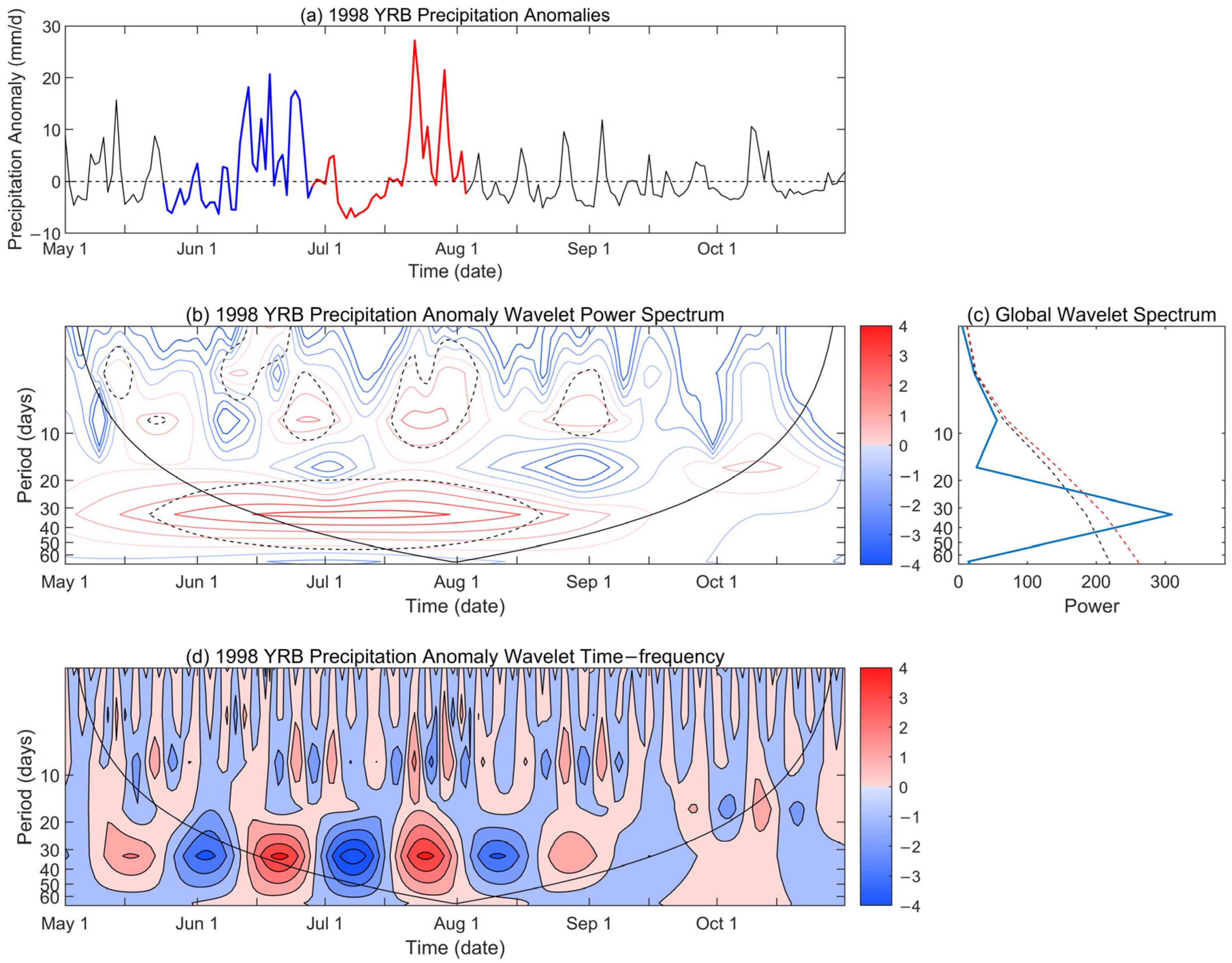

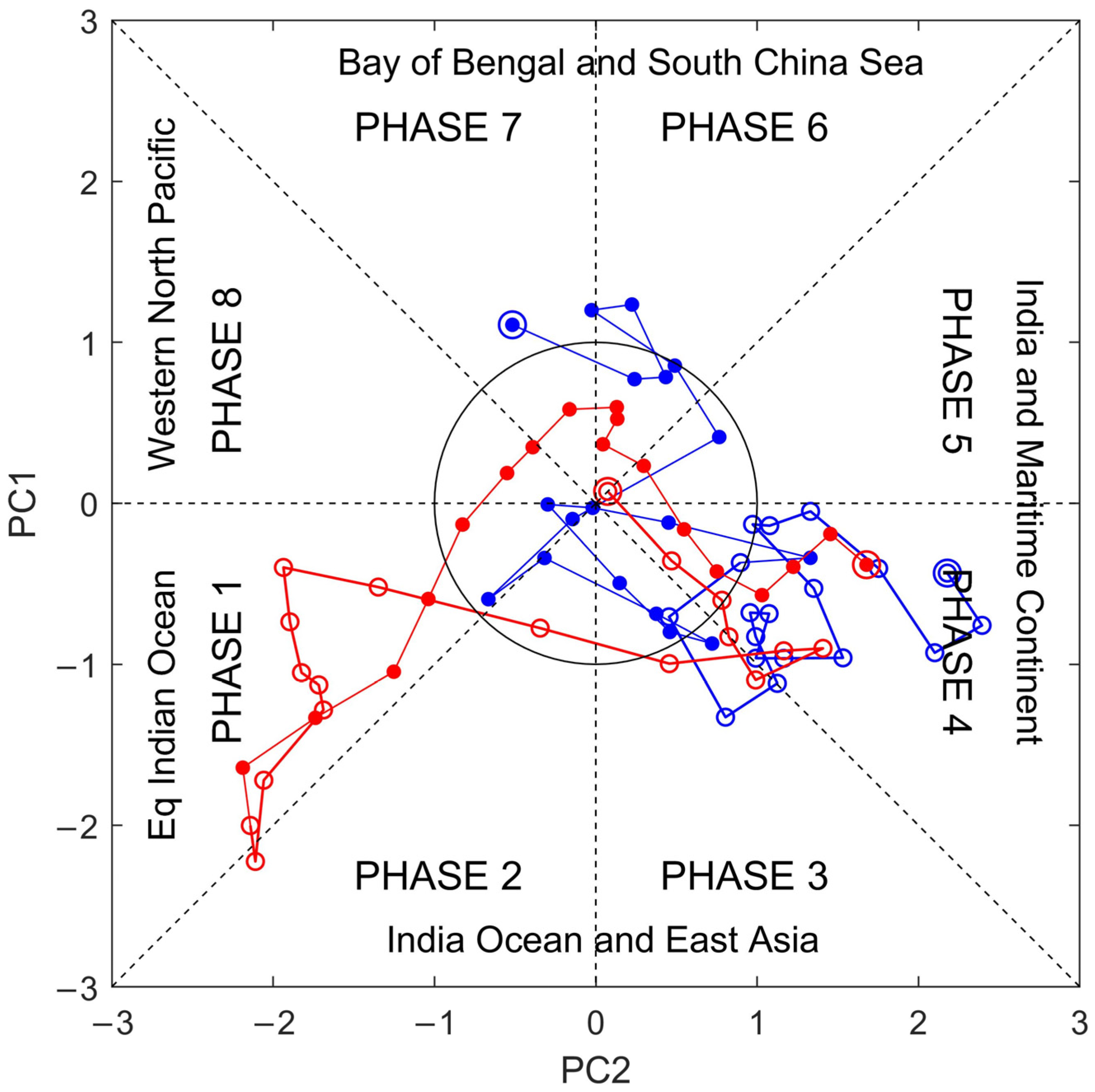
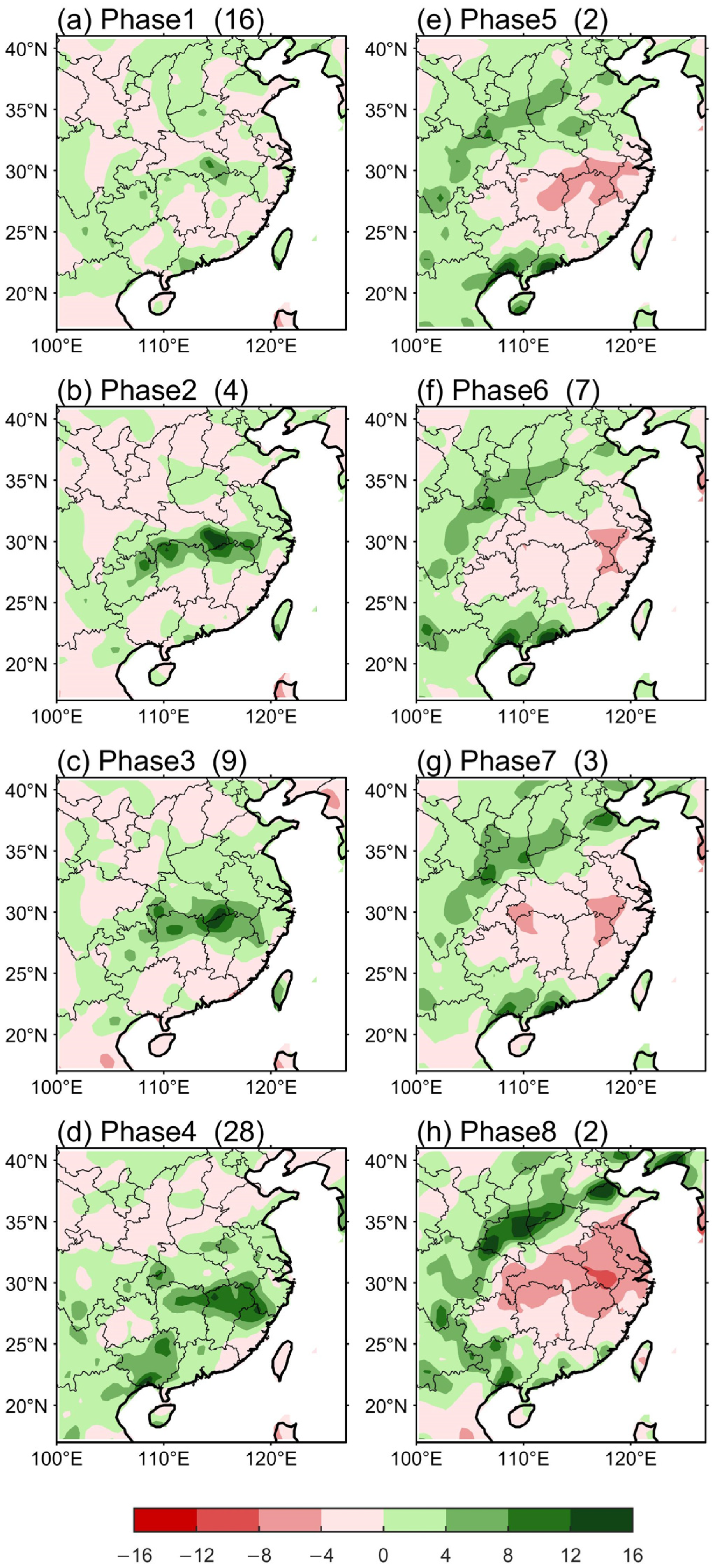
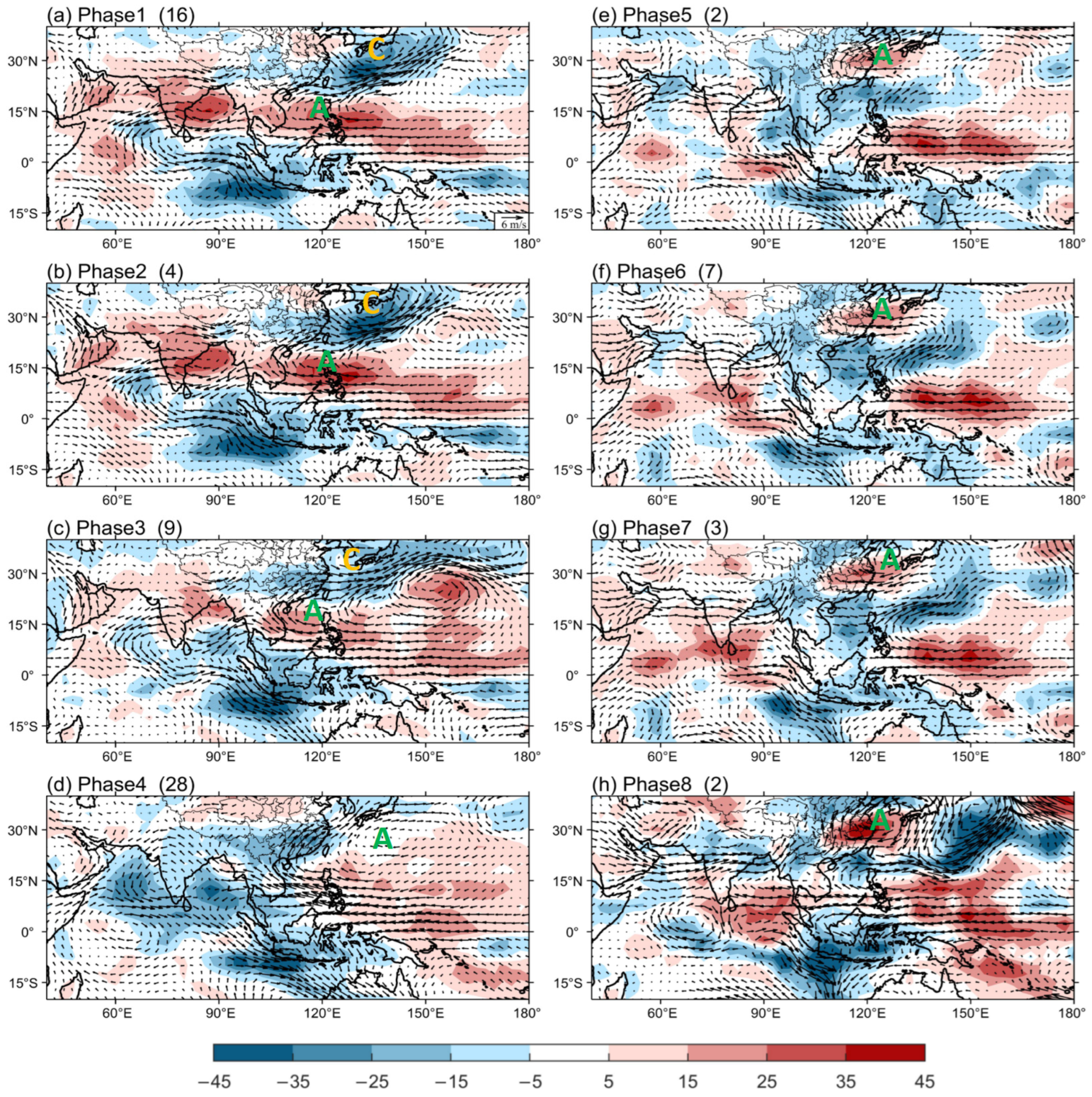
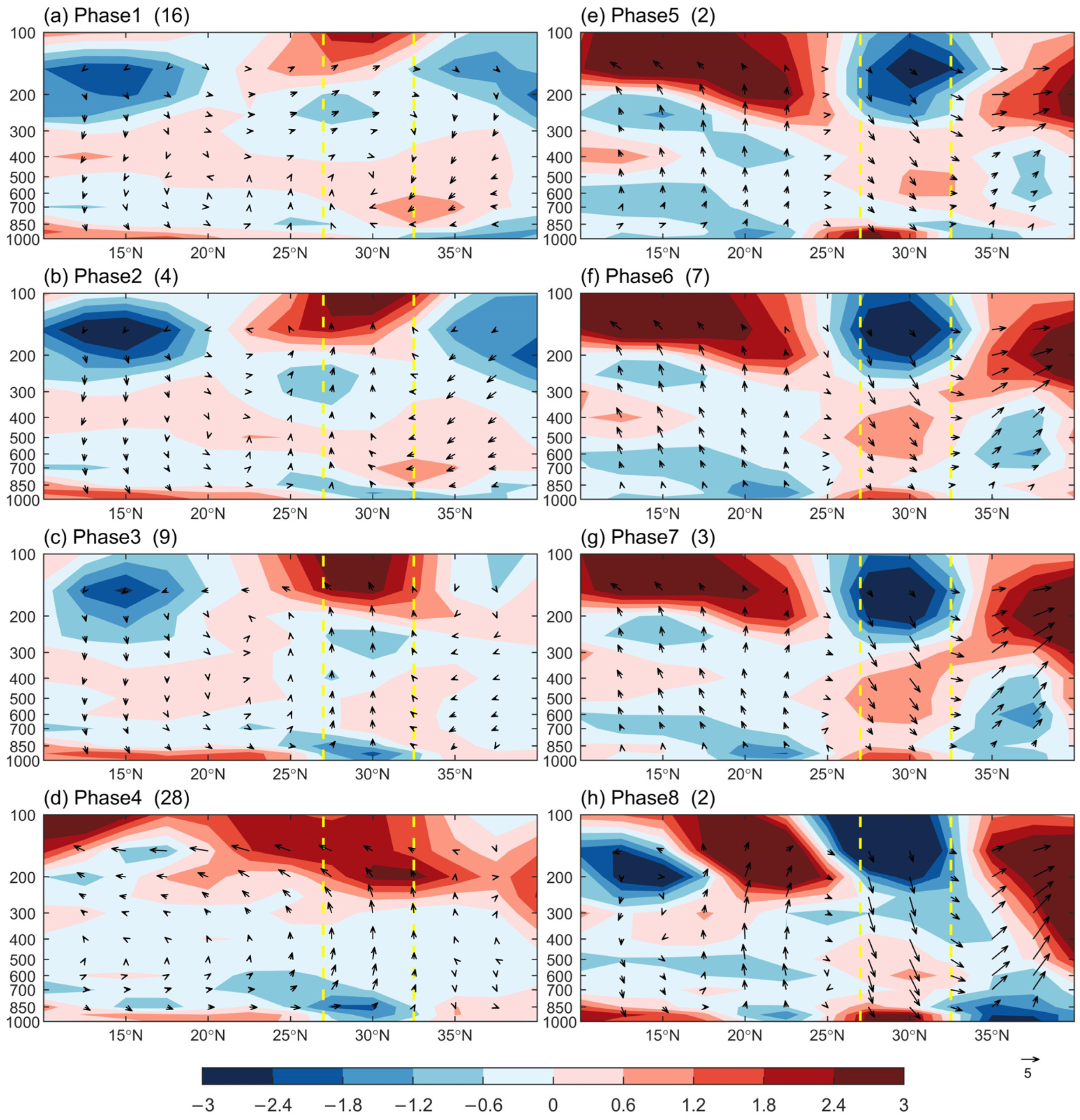

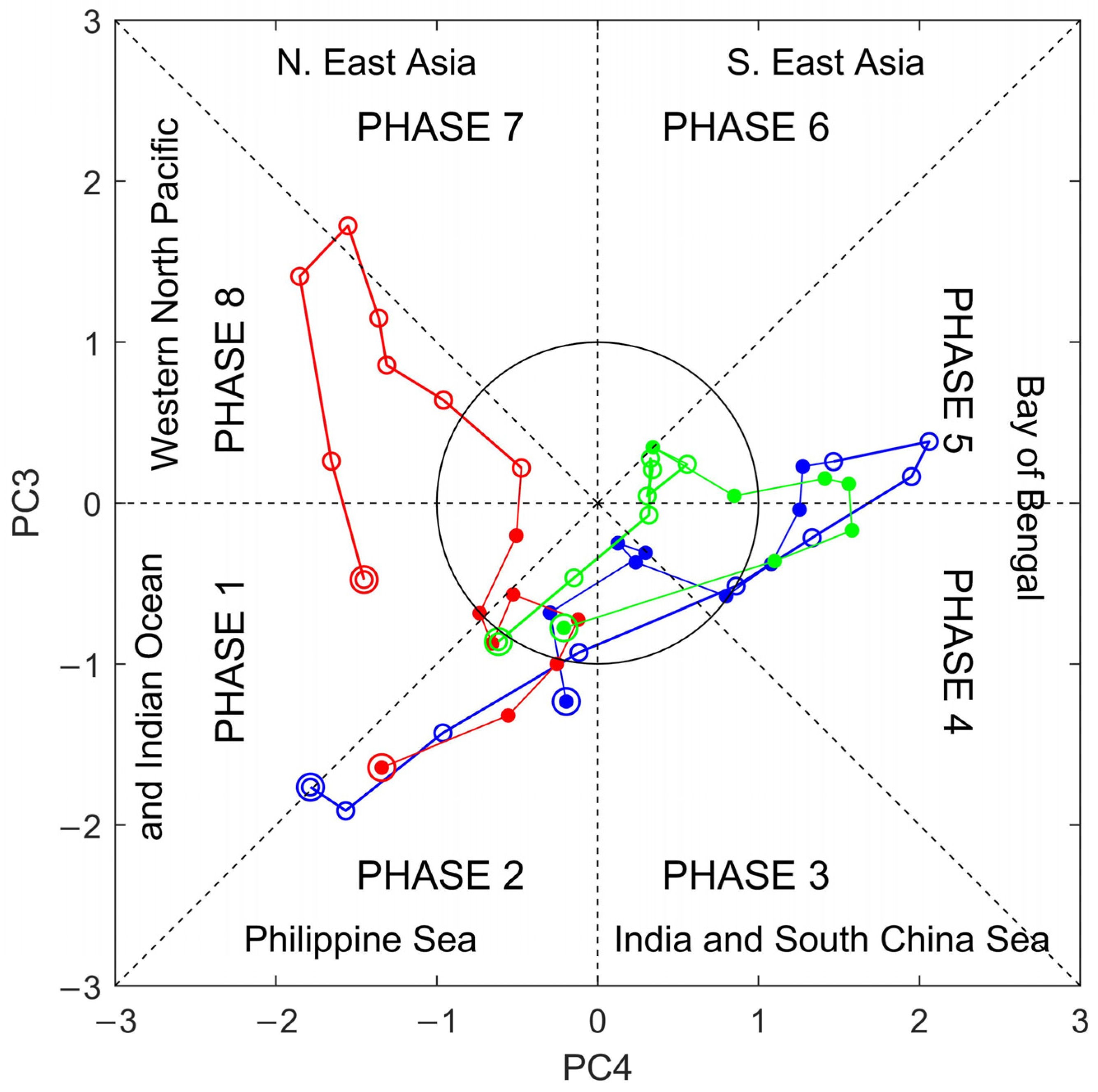



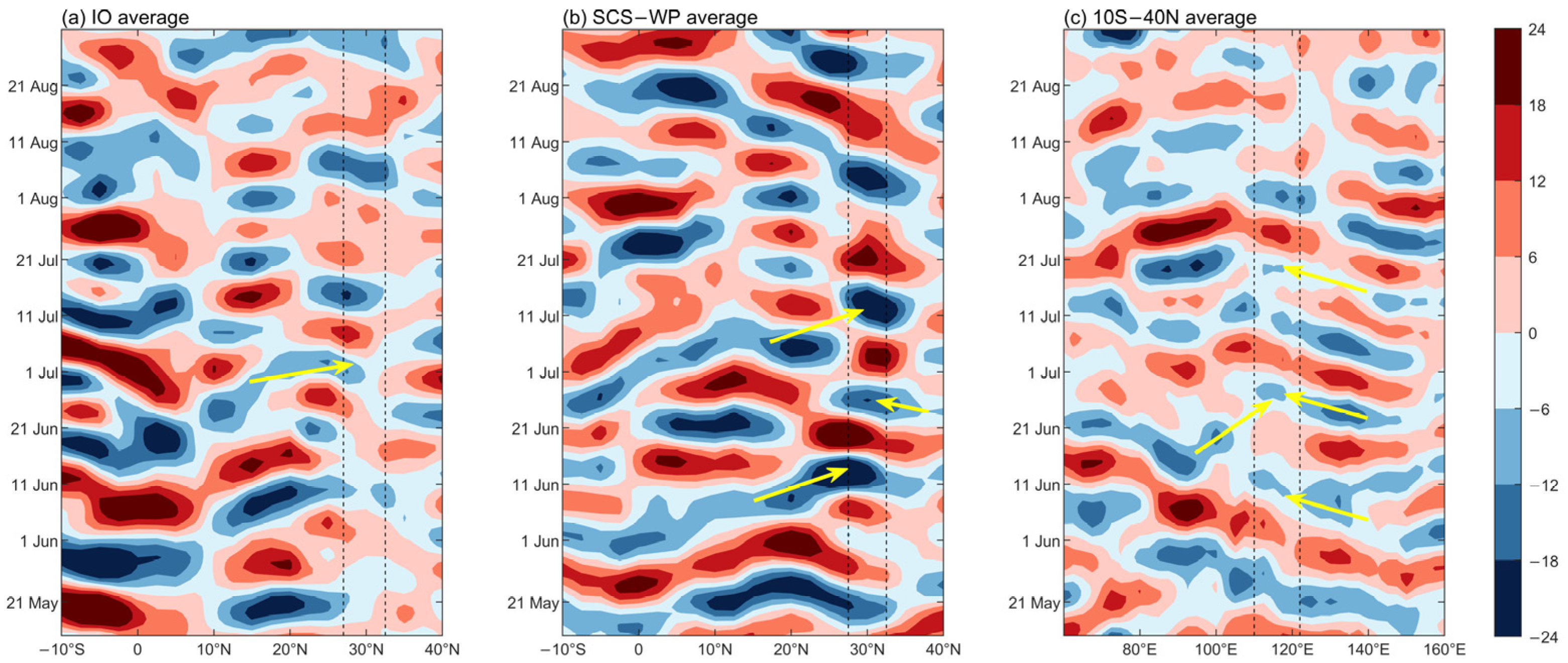

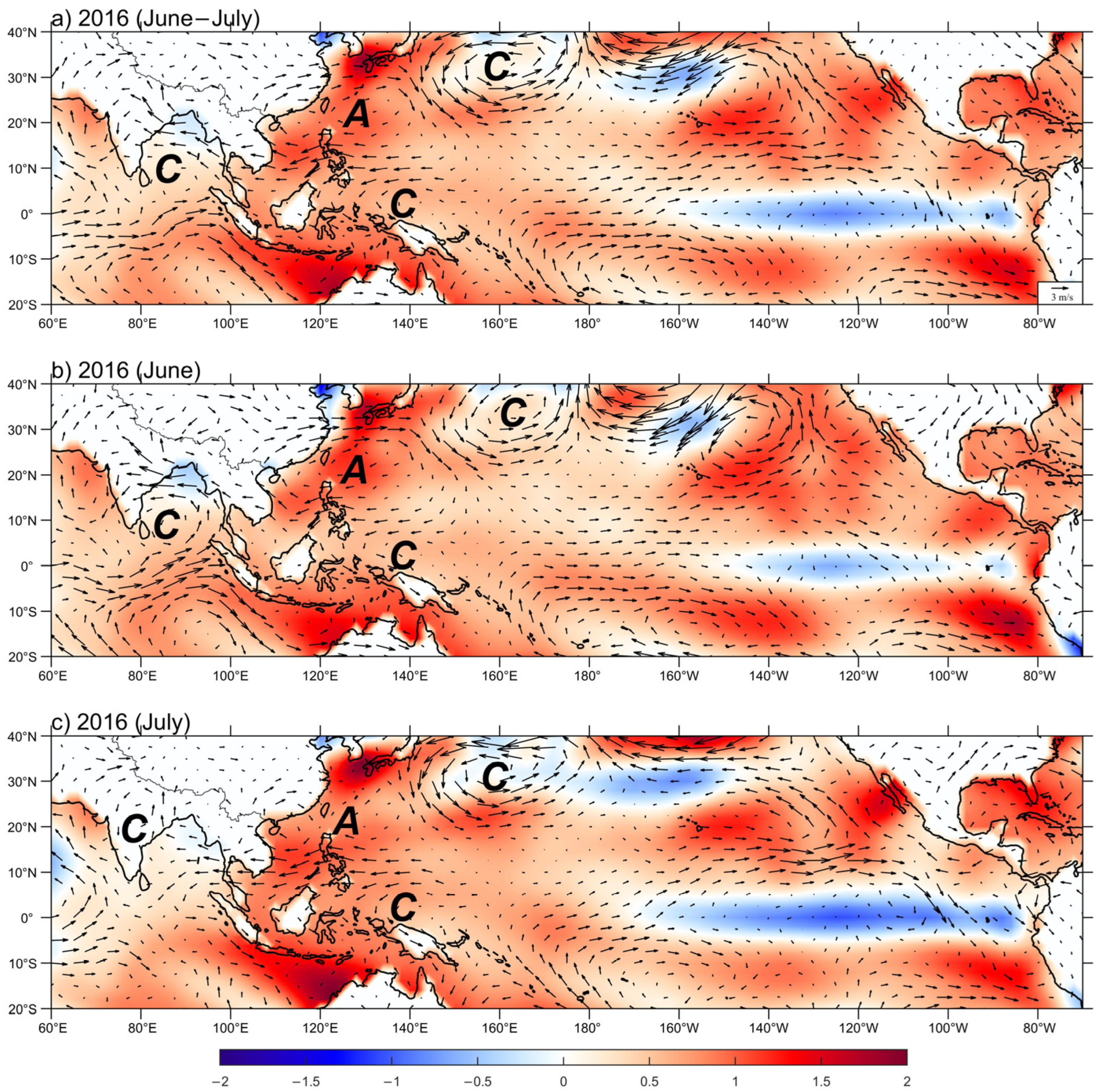
| Year | BSISO | Number of Rainfall Events | Phases for Wet or Dry Episode | Source of BSISO and Other ISO | SST and Atmospheric Circulation |
|---|---|---|---|---|---|
| 1998 | BSISO1 (30–60-day oscillation) | 2 | wet episode: phases 1–4 dry episode: phases 5–8 | event 1: SCS–WP/IO event 2: SCS–WP | cold SST anomalies appearing in central equator Pacific
|
| 2016 | BSISO2 (10–30-day oscillation) | 3 | wet episode: phases 1–2/7–8 dry episode: phases 3–6 | event 1: SCS–WP event 2: IO, extratropical WP event 3: SCS–WP | without cold SST anomalies appearing in central equator Pacific
|
Disclaimer/Publisher’s Note: The statements, opinions and data contained in all publications are solely those of the individual author(s) and contributor(s) and not of MDPI and/or the editor(s). MDPI and/or the editor(s) disclaim responsibility for any injury to people or property resulting from any ideas, methods, instructions or products referred to in the content. |
© 2023 by the authors. Licensee MDPI, Basel, Switzerland. This article is an open access article distributed under the terms and conditions of the Creative Commons Attribution (CC BY) license (https://creativecommons.org/licenses/by/4.0/).
Share and Cite
Tao, M.; Yan, L.; Zheng, S.; Xu, J.; Chen, Y. Contrasting the Impacts of Intraseasonal Oscillations on Yangtze Precipitation during the Summer of 1998 and 2016. Atmosphere 2023, 14, 1695. https://doi.org/10.3390/atmos14111695
Tao M, Yan L, Zheng S, Xu J, Chen Y. Contrasting the Impacts of Intraseasonal Oscillations on Yangtze Precipitation during the Summer of 1998 and 2016. Atmosphere. 2023; 14(11):1695. https://doi.org/10.3390/atmos14111695
Chicago/Turabian StyleTao, Mimi, Li Yan, Shaojun Zheng, Jianjun Xu, and Yinlan Chen. 2023. "Contrasting the Impacts of Intraseasonal Oscillations on Yangtze Precipitation during the Summer of 1998 and 2016" Atmosphere 14, no. 11: 1695. https://doi.org/10.3390/atmos14111695
APA StyleTao, M., Yan, L., Zheng, S., Xu, J., & Chen, Y. (2023). Contrasting the Impacts of Intraseasonal Oscillations on Yangtze Precipitation during the Summer of 1998 and 2016. Atmosphere, 14(11), 1695. https://doi.org/10.3390/atmos14111695








